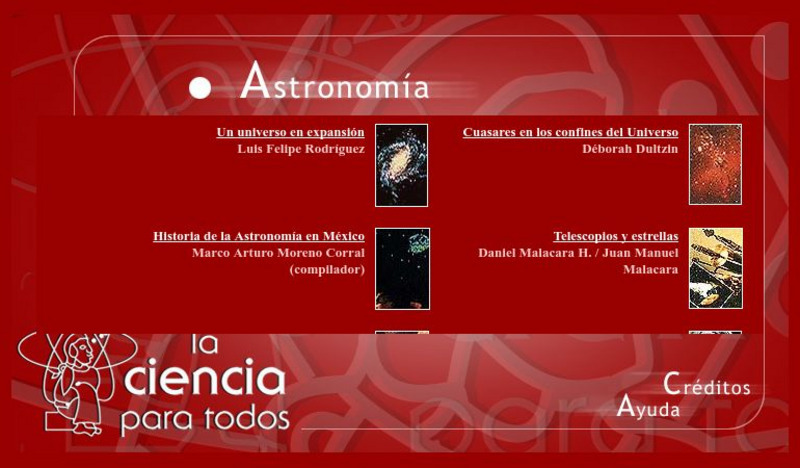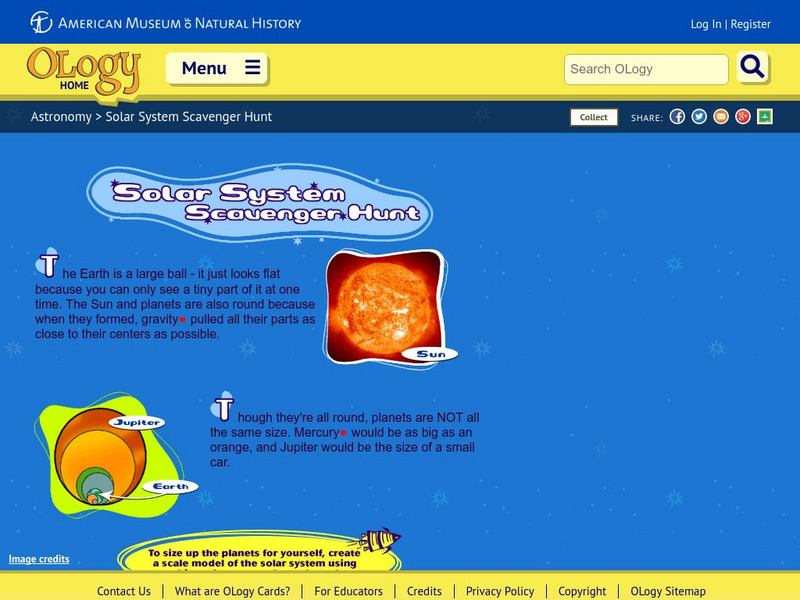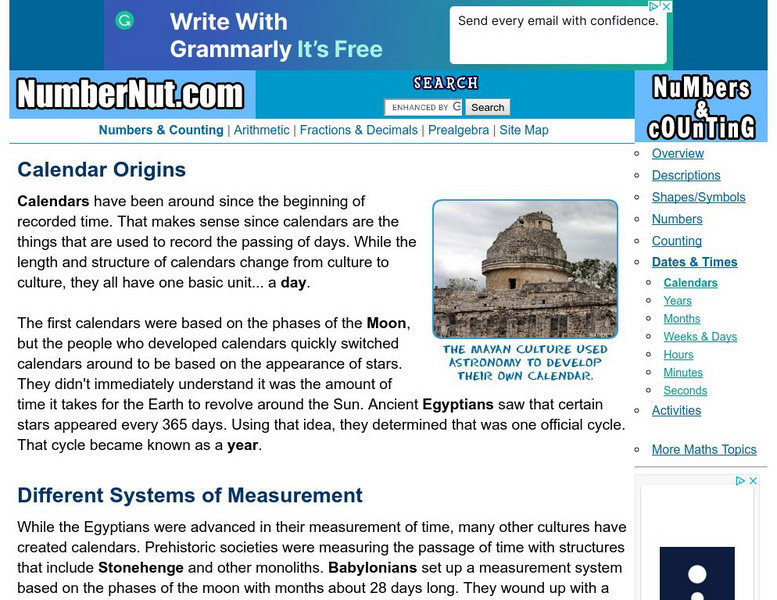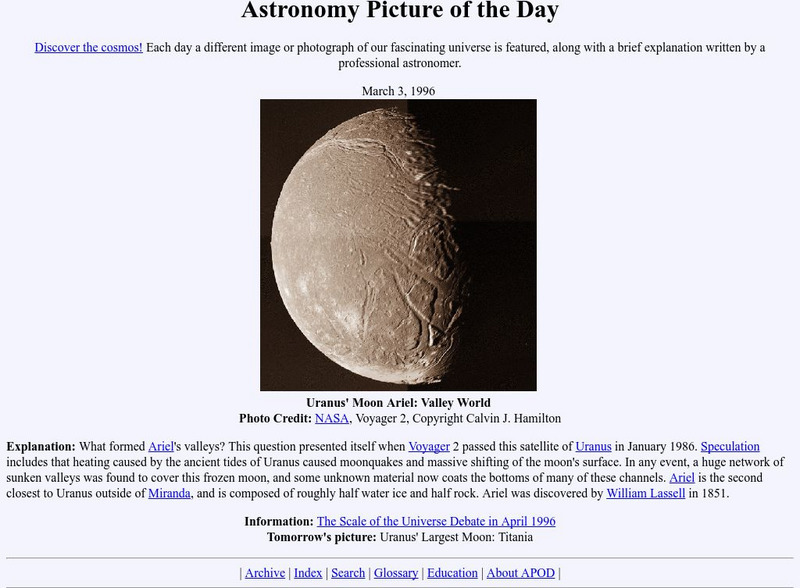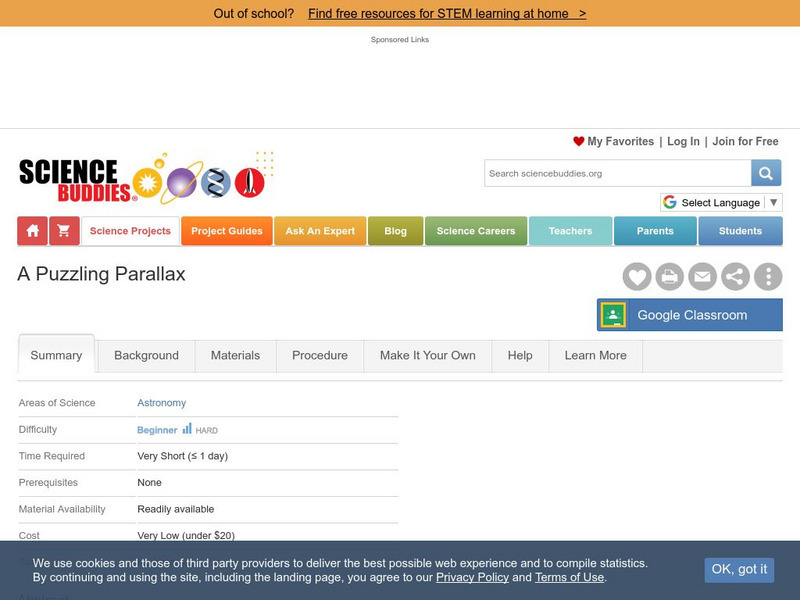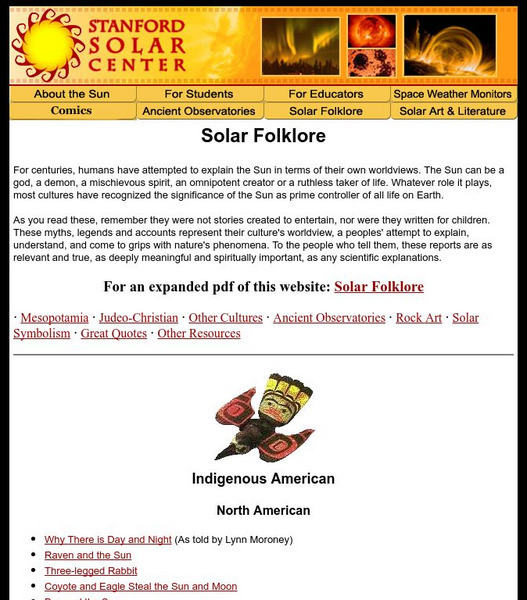Hi, what do you want to do?
Other
The Astrolabe: Home Page
This site provides a very general overview of astrolabe principles with links to other pages for more detailed information.
Other
Astrolabe.org: The Astrolabe
A description of the ancient astrolabes and how they worked. Provides information about definitions, collections, and also includes photos.
Discovery Education
Discovery Education: Lesson Plans Library K 5
This resource presents a lesson plan library which holds hundreds of lesson plans organized by grade level and subject area. Often rooted with an Internet research piece, each lesson plan contains specific objectives, procedures,...
Other
Seds Usa: Charles Messier
Charles Messier (1730-1817 CE) is credited for discovering 13 comets. He also began the Catalog of Nebulae and Star Clusters. This catalog as well as a great deal of information on Messier is available here. The Messier objects are also...
Instituto Latinoamericano de la Comunicacion Educativa
La Ciencia Para Todos: Astronomia
In this site you will find several Astronomy topics such as: the expansion of the Universe, history of Astronomy in Mexico, quasars in the confine of the Universe and telescopes and stars.Read phonetically
Other
Discover Magazine
Discover Magazine brings you the world of science: the latest research news, enhanced versions of articles, and a full-text archive.
Ducksters
Ducksters: Ancient Mesopotamia: Science, Inventions, and Technology
Kids learn about the Science, Inventions, and Technology of Ancient Mesopotamia such as writing, the wheel, astronomy, and government on this site.
American Museum of Natural History
American Museum of Natural History: O Logy: Stuff to Do: Scavenger Hunt
Illustrated instructions for creating a scale model of the solar system.
NumberNut
Number Nut: Calendar Origins
History and mathematics merge in this lesson that explores the origin of the calendar. Learn how it all got started in this detailed lesson that includes a simple months of the year game and a more challenging time conversion game. Both...
American Museum of Natural History
American Museum of Natural History: Meet the Universe's Main Attraction Gravity
Illustrated and animated series of short articles answers the questions, what is gravity? and what does it do?
NASA
Nasa: Astronomy Picture of the Day: Uranus's Moon Ariel
Provides a brief overview of Ariel, one of Uranus's moons. Details how its deep valleys were formed. A NASA astronomy picture of the day.
Other
Kitt Peak National Observatory
Homepage of Kitt Peak National Observatory (KPNO) which is the one of the premier astronomical observatory used by professional astronomers in the United States. Although the site is mostly geared toward the professional, the Kitt Peak...
Science Buddies
Science Buddies: A Puzzling Parallax
Did you know that ancient astronomers could measure the distance to other stars? They could also distinguish between stars and planets. How could they do that without modern technology of telescopes? See if you can discover the link...
Other
Teach With Movies: Lesson Plans Based on Shorts and Clips
Links to many video-clip based lessons in the areas of health, English language arts & drama, mathematics, music, biology, earth science, inventions, astronomy, physics, chemistry, U.S. history and culture, and world history and...
Libre Text
Libre Texts: Chemistry: Black Hole Thermodynamics
Why did black holes enter the realm of thermodynamics? This concise article dives into the history.
Knowledge Share
Super Kids: Hangman
Use this interactive site to enhance students' spelling and vocabulary while refreshing their memories in history, geography, language, science, and entertainment. It is available to use on line or you can purchase leveled apps for the...
Stanford University
Solar Folklore
Folktales from many cultures around the world about the sun. There is also information available about ancient astronomy.
Curated OER
University of St Andrews: Colin Maclaurin
This page from the University of St. Andrews offers an excellent biography on Colin Maclaurin, a Scottish mathematician and teacher(1698-1746.) Discusses his life and his contributions to mathematics and, to an extent, astronomy.
Curated OER
University of St. Andrews: Alcuin of York
This site from the University of St. Andrews provides a biography on Alcuin which discusses his development of the Carolingian minuscule, his time as headmaster at Charlemagne's Palace School, and his elementary texts on arithmetic,...
Curated OER
University of St Andrews: Eratosthenes
This site, which is provided for by the University of St Andrews, gives an extensive biography of Eratosthenes detailing his accomplishments in mathematics and astronomy.
American Museum of Natural History
American Museum of Natural History: O Logy: Stuff to Do: Build the Big Dipper
Illustrated instructions for building a Big Dipper mobile.
Curated OER
Ancient Greek Philosophy: Thales of Miletus
Includes a short summary of the life and work of the Greek philosopher Thales of Miletus. Discusses his life, work in Astronomy and Mathematics, and view of water and pantheism. Also includes a couple of quotations that make reference to...
TED Talks
Ted: Ted Ed: Music and Creativity in Ancient Greece
You think you love music? You have nothing on the Ancient Greek obsession. Every aspect of Greek life was punctuated by song: history, poetry, theater, sports and even astronomy. In fact, music was so important to Greek philosopher Plato...
Other
St. Bede a Biography by Catholic Community Forum
A biographical note on St. Bede (672-735), the monk, scholar, and author who wrote about history, rhetoric, mathematics, music, astronomy, poetry, grammar, philosophy, hagiography, homiletics, and Bible commentary.









